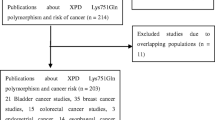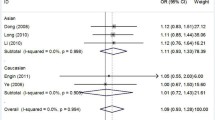Abstract
Studies on the polymorphisms of Xeroderma Pigmentosum Group D (XPD) have shown inconclusive trends in the risk of bladder cancer. The purpose of this study is to evaluate the role of XPD single nucleotide polymorphisms in bladder cancer susceptibility. We performed a meta-analysis on all available studies, which included 5,368 and 6,683 XPD Lys751Gln cases and controls and 3,220 and 4,391 Asp312Asn cases and controls, respectively. Overall, Significant risk effects of Lys751Gln genotype was found under recessive model contrast [Gln/Gln vs. (Gln/Lys + Lys/Lys)] [P = 0.04, OR = 1.12; 95% CI (1.01, 1.26)], and subtle but insignificantly increased risks between Lys751Gln and bladder cancer were observed under allele contrast (Gln vs. Lys) and homologous contrast (Gln/Gln vs. Lys/Lys) in all subjects. The 751Gln allele had no significant effect on bladder cancer in all subgroups (Asian, Caucasian and USA). Significant risk effects of Asp312Asn polymorphism on bladder susceptibility were observed in all subjects under all genetic contrasts, however, stratified analyses showed that the 312Asn allele showed different risk effects in USA and Caucasian. The Gln/Gln genotype acts as a risk factor in its association with bladder cancer, and the effect of Lys751Gln polymorphism on bladder susceptibility should be studied with larger, stratified population; the 312Asn allele has an important role in the etiology of bladder cancer whereas the ethnic background should be carefully concerned in further studies.



Similar content being viewed by others
References
Sanyal S, Festa F, Sakano S et al (2004) Polymorphisms in DNA repair and metabolic genes in bladder cancer. Carcinogenesis 25:729–734
Cohen SM, Shirai T, Steineck G (2000) Epidemiology and etiology of premalignant and malignant urothelial changes. Scand J Urol Nephrol Suppl 205:105–115
Cavalieri E, Frenkel K, Liehr JG et al (2000) Estrogens as endogenous genotoxic agents—DNA adducts and mutations. J Natl Cancer Inst Monogr 27:75–93
Johnson-Thompson MC, Guthrie J (2000) Ongoing research to identify environmental risk factors in breast carcinoma. Cancer 88:1224–1229
Berwick M, Matullo G, Vineis P (2002) Studies of DNA repair and human cancer: an update. Lewis, Boca Raton
Squire JA, Whitmore GF, Phillips RA (1998) Genetic basis of cancer. In: Hill RP, Tannock IF (eds) The basic science of oncology. McGraw-Hill, New York, pp 48–78
Friedberg EC (2001) How nucleotide excision repair protects against cancer. Nat Rev Cancer 1:22–33
Goode EL, Ulrich CM, Potter JD (2002) Polymorphisms in DNA repair genes and associations with cancer risk. Cancer Epidemiol Biomarkers Prev 11:1513–1530
Benhamou S, Sarasin A (2002) ERCC2/XPD gene polymorphisms and cancer risk. Mutagenesis 17:463–469
Shen MR, Jones IM, Mohrenweiser H (1998) Nonconservative amino acid substitution variants exist at polymorphic frequency in DNA repair genes in healthy humans. Cancer Res 58:604–608
Shao J, Gu M, Xu Z et al (2007) Polymorphisms of the DNA gene XPD and risk of bladder cancer in a Southeastern Chinese population. Cancer Genet Cytogenet 177:30–36
Stern MC, Johnson LR, Bell DA et al (2002) XPD codon 751 polymorphism, metabolism genes, smoking, and bladder cancer risk. Cancer Epidemiol Biomarkers Prev 11:1004–1011
Fontana L, Bosviel R, Delort L et al (2008) DNA repair gene ERCC2, XPC, XRCC1, XRCC3 polymorphisms and associations with bladder cancer risk in a French cohort. Anticancer Res 28:1853–1856
Schabath MB, Delclos GL, Grossman HB et al (2005) Polymorphisms in XPD exons 10 and 23 and bladder cancer risk. Cancer Epidemiol Biomarkers Prev 14:878–884
Matullo G, Guarrera S, Sacerdote C et al (2005) Polymorphisms/haplotypes in DNA repair genes and smoking: a bladder cancer case–control study. Cancer Epidemiol Biomarkers Prev 14:2569–2578
Andrew AS, Karagas MR, Nelson HH et al (2008) DNA repair polymorphisms modify bladder cancer risk: a multi-factor analytic strategy. Hum Hered 65:105–118
Wu X, Gu J, Grossman HB et al (2006) Bladder cancer predisposition: a multigenic approach to DNA-repair and cell-cycle-control genes. Am J Hum Genet 78:464–479
Gangwar R, Ahirwar D, Mandhani A et al (2009) Influence of XPD and APE1 DNA repair gene polymorphism on bladder cancer susceptibility in north India. Urology 73:675–680
Matullo G, Dunning AM, Guarrera S et al (2006) DNA repair polymorphisms and cancer risk in non-smokers in a cohort study. Carcinogenesis 27:997–1007
Lau J, Ioannidis JP, Schmid CH (1997) Quantitative synthesis in systematic reviews. Ann Intern Med 127:820–826
Higgins JP, Thompson SG, Deeks JJ et al (2003) Measuring inconsistency in meta-analyses. BMJ 327:557–560
Higgins JP, Thompson SG (2002) Quantifying heterogeneity in a meta-analysis. Stat Med 21:1539–1558
Egger M, Davey Smith G, Schneider M et al (1997) Bias in meta-analysis detected by a simple, graphical test. BMJ 315:629–634
Matullo G, Guarrera S, Carturan S et al (2001) DNA repair gene polymorphisms, bulky DNA adducts in white blood cells and bladder cancer in a case–control study. Int J Cancer 92:562–567
García-Closas M, Malats N, Real FX et al (2006) Genetic variation in the nucleotide excision repair pathway and bladder cancer risk. Cancer Epidemiol Biomarkers Prev 15:536–542
Narter KF, Ergen A, Agaçhan B et al (2009) Bladder cancer and polymorphisms of DNA repair genes (XRCC1, XRCC3, XPD, XPG, APE1, hOGG1). Anticancer Res 29:1389–1393
Shen M, Hung RJ, Brennan P et al (2003) Polymorphisms of the DNA repair genes XRCC1, XRCC3, XPD, interaction with environmental exposures, and bladder cancer risk in a case–control study in northern Italy. Cancer Epidemiol Biomarkers Prev 12:1234–1240
Andrew AS, Nelson HH, Kelsey KT et al (2006) Concordance of multiple analytical approaches demonstrates a complex relationship between DNA repair gene SNPs, smoking and bladder cancer susceptibility. Carcinogenesis 27:1030–1037
Weber CA, Salazar EP, Stewart SA et al (1988) Molecular cloning and biological characterization of a human gene, ERCC2, that corrects the nucleotide excision repair defect in CHO UV5 cells. Mol Cell Biol 8:1137–1146
Laine JP, Mocquet V, Egly JM (2006) TFIIH enzymatic activities in transcription and nucleotide excision repair. Methods Enzymol 408:246–263
Wang XW, Vermeulen W, Coursen JD et al (1996) The XPB and XPD DNA helicases are components of the p53-mediated apoptosis pathway. Genes Dev 10:1219–1232
Lehmann AR (2001) The xeroderma pigmentosum group D (XPD) gene: one gene, two functions, three diseases. Genes Dev 15:15–23
Coin F, Marinoni JC, Rodolfo C et al (1998) Mutations in the XPD helicase gene result in XP and TTD phenotypes, preventing interaction between XPD and the p44 subunit of TFIIH. Nat Genet 20:184–188
Au WW, Navasumrit P, Ruchirawat M (2004) Use of biomarkers to characterize functions of polymorphic DNA repair genotypes. Int J Hyg Environ Health 207:301–313
Vodicka P, Kumar R, Stetina R et al (2004) Genetic polymorphisms in DNA repair genes and possible links with DNA repair rates, chromosomal aberrations and single-strand breaks in DNA. Carcinogenesis 25:757–763
Pavanello S, Pulliero A, Siwinska E et al (2005) Reduced nucleotide excision repair and GSTM1-null genotypes influence anti-β [α] PDE-DNA adduct levels in mononuclear white blood cells of highly PAH-exposed coke oven workers. Carcinogenesis 26:169
Wang M, Gu D, Zhang Z et al (2009) XPD polymorphisms, cigarette smoking, and bladder cancer risk: a meta-analysis. J Toxicol Environ Health A 72:698–705
Author information
Authors and Affiliations
Corresponding author
Rights and permissions
About this article
Cite this article
Li, C., Jiang, Z. & Liu, X. XPD Lys751Gln and Asp312Asn polymorphisms and bladder cancer risk: a meta-analysis. Mol Biol Rep 37, 301–309 (2010). https://doi.org/10.1007/s11033-009-9693-1
Received:
Accepted:
Published:
Issue Date:
DOI: https://doi.org/10.1007/s11033-009-9693-1




